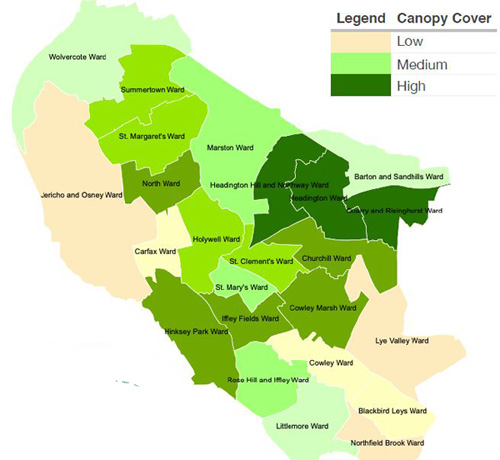Urban forests offer numerous benefits (also called ecosystem services) that help make our towns and cities better places to live. Trees in urban areas play a vital role in air purification, wellbeing enhancement, carbon storage, flood reduction, and wildlife habitat provision, among other benefits.
In summer 2018, Oxford City Council partnered with Treeconomics to survey Oxford's trees using i-Tree Eco. This survey quantified the structure of Oxford’s urban forest and valued the range of benefits it provides.

Key findings from the survey
Oxford’s urban forest contains an estimated 248,200 trees. That’s nearly two trees per person – double the ratio for London.
These trees:
- cover an area of 725ha (equivalent to 725 football fields), with a leaf area of 31km²
- intercept about 255,000 cubic metres of rainwater annually, saving around £81,000 in stormwater treatment costs
- filter approximately 65 tonnes of airborne pollutants yearly, valued at over £1.12 million in social damage costs
- remove around 2,500 tonnes of carbon from the atmosphere annually, worth £619,000
- store approximately 76,400 tonnes of carbon, valued at £18.8 million
Interesting facts about Oxford's trees
- total number of trees: 248,200
- annual benefits worth over £1.8 million
- canopy cover: 22.3% (15.9% trees, 6.4% shrubs)
- diversity: 73 tree species
- density: 54 trees per hectare
- most common trees: ash, willow and poplar
How the survey was carried out
The survey was conducted across 200 randomly allocated plots by teams of trained volunteers and professionals, covering both public and private lands in Oxford. It included detailed measurements and assessments of tree species, height, trunk diameter, canopy spread, and surrounding land use.
Study conclusions
Oxford’s urban forest is providing a valuable benefit to all of its residents and visitors. For example, the filtration of sulphur dioxide alone is equivalent to the emissions of over 11,000 cars every year.
However there are challenges too. Ash Dieback and Xyella diseases threaten around 16% of Oxford’s tree resource and this could have a devastating effect on the provision of benefits.
Understanding urban forest composition is the first step in the proactive management of this important resource.
Now we can begin to strategically plan to improve and maintain our urban forest. By all working together we can ensure that Oxford's Urban Forest continues to provide benefits long into the future.
Next steps
Download the Oxford i-Tree Eco Study report, which was published in February 2021.
The i-Tree Eco Study formed the basis of our Urban Forest Strategy - A Master Plan to 2050, which was adopted in September 2021.
For more on trees and their benefits, visit the Trees Design Action Group website.
More about i-Tree
i-Tree Eco is a state-of-the-art, peer-reviewed software suite from the USDA Forest Service that quantifies the structure and functions of community trees and urban forests. It is adaptable, open-source and free to use.
Project funders

Study partners

Download our leaflet
For more insights, download the Oxford i-Tree Eco Study leaflet.

